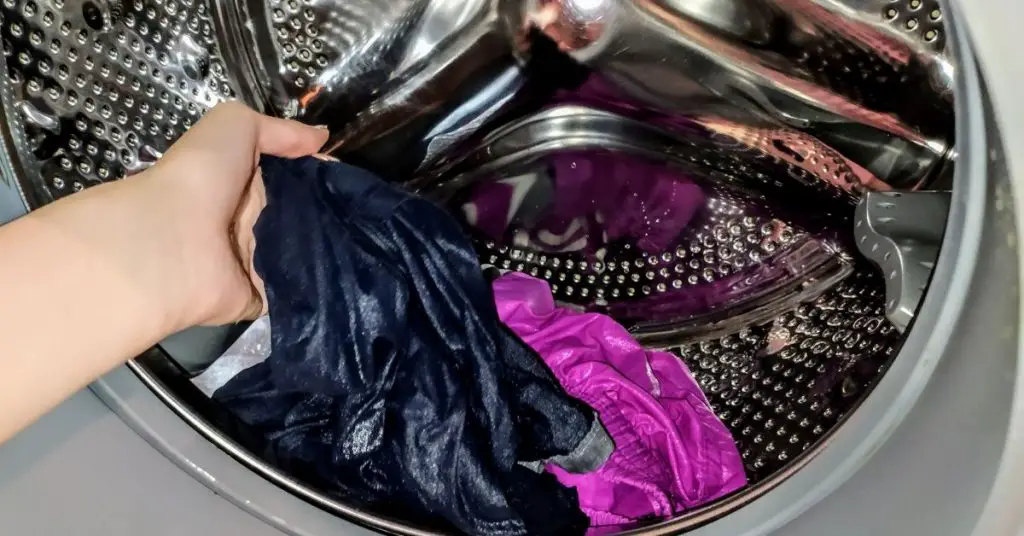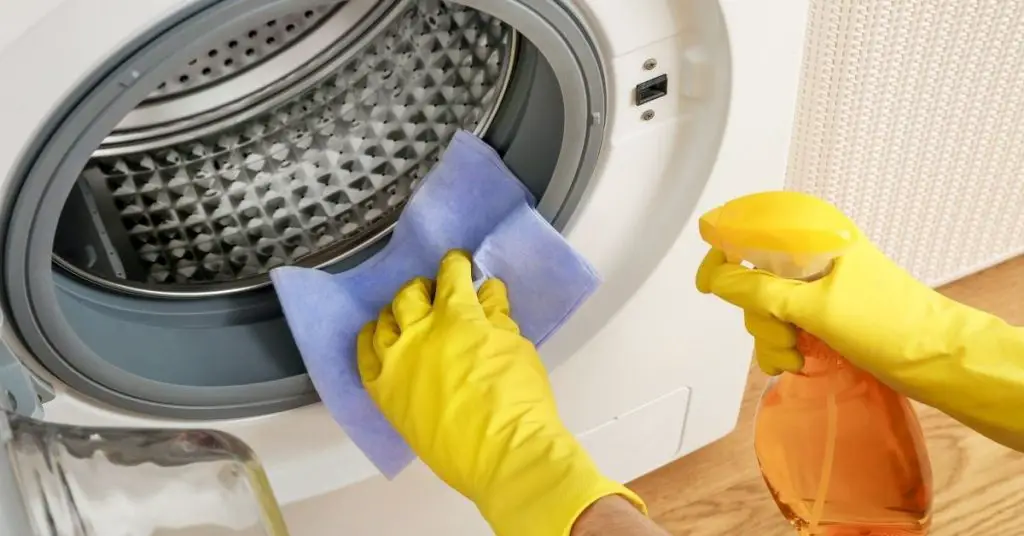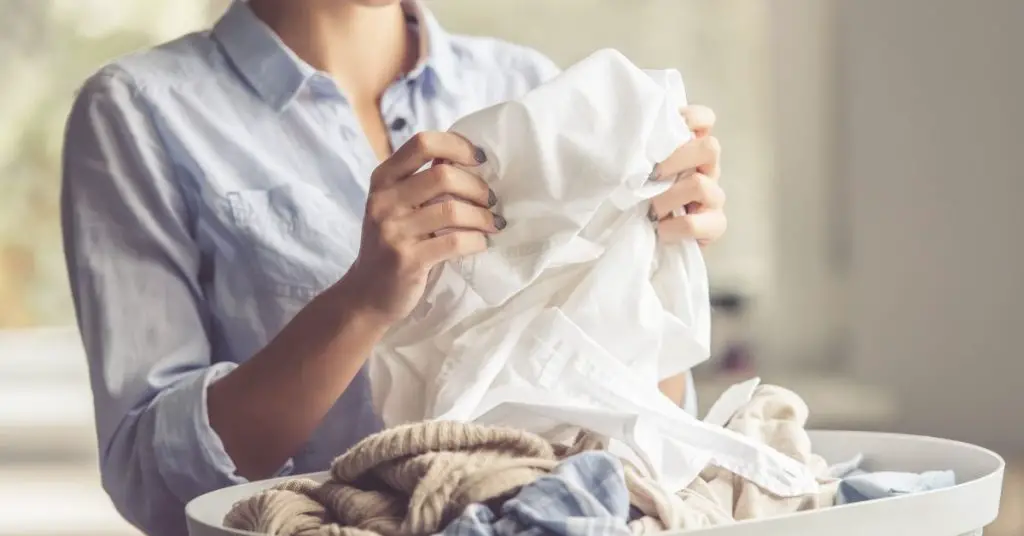How to Stop Clothes Smelling Damp When Drying Inside Your Home
Is there anything more annoying than rushing around in the morning, getting dressed and then realising your outfit has that musty, damp smell?
Having to re-wash and re-dry clothes is time-consuming and a waste of money and water.
But unfortunately, the damp smell is noticeable – and embarrassing when you realise it’s coming from you.
Luckily, there are some great tips for how to stop clothes smelling damp. So we’ve rounded them all up here so you can kill that damp smell once and for all.
The damp smell can occur in different parts of the laundry routine.
And, if it’s not dealt with, it will stick around until the clothes are re-washed.
Most commonly, the musty odour will start to appear when clothes are drying inside.
However, washing machines and tumble dryers can both grow mould and mildew which then transfers onto our laundry.

We’ve split this post into the following sections, so you can find the best advice for your specific situation:
Where Does the Damp Smell Come From?
We explain what causes the damp smell so you’re better equipped to know how to tackle it.
How to Stop Clothes Smelling Damp
Tips for when you’re sure it’s the clothes themselves that are the cause of the damp smell.
How to Stop Clothes Smelling Damp When Drying Inside
Tips on how to dry clothes inside without them smelling damp and musty.
How to Get Rid of Damp Smell in Clothes If Your Washing Machine Smells Musty
How to clean a washing machine and remove mould and mildew odours.
What to Do If Clothes Smell Damp After Tumble Drying
Tips for when clothes smell fresh after the washing machine, but damp after the tumble dryer.
Where Does the Damp Smell Come From?
It’s much easier to know how to stop clothes smelling damp if you know what’s causing the smell, and what it actually is.
In most cases, the musty smell is caused by the presence of mould and mildew.
This either attaches onto fabrics during the washing or drying cycle, or grows from damp clothes being unable to properly dry.
Once the mould has grown or attached to the fabric, it will stick there until it’s removed.
This is why even after clothes are dry and folded away, that musty smell is still there.
Based on this, you may be able to work out which stage of your laundry routine is causing the damp smell to appear.
If you already know, then skip to the relative section below to see some possible ways of treating it once and for all.
If you’re not sure where the damp is coming from, keep reading to see if you can potentially narrow down the source and test out some of our suggestions.

How to Stop Clothes Smelling Damp
Generally, damp smells will either be caused by the drying environment or the washing environment.
By this, we mean that the damp smell either emerges in the washing machine or whilst the clothes are drying.
We’ve split our tips into categories so you can find the tips that will work for your situation.
How to stop the damp smell when drying clothes is up first, followed by how to stop damp from occurring in the washing machine.
The final section covers what to do if clothes smell damp after tumble drying.
However, if you’re sure that it’s the clothes themselves that are causing the damp smell, then try adding white vinegar or colour-safe bleach to the washing load.
White vinegar and bleach are both brilliant at killing mould and mildew, but it’s best to use colour-safe with clothes to avoid permanent staining.
Our Clean and Tidy Living article Where to Buy White Vinegar For Cleaning In The UK is packed with tips for where and how to use white vinegar for cleaning.
How to Stop Clothes Smelling Damp When Drying Inside
If you’re drying clothes inside and a damp smell is emerging, it usually means that the air has too much moisture.
This commonly occurs in small spaces where there’s less room for moisture particles to disperse which condenses and causes humidity in a room – such as in flats or laundry rooms.
When clothes and towels take longer to dry, it allows mould and mildew to grow from the wet fabric.
The quicker clothes dry, the less chance the mould spores have to grow and cause a smell.
Having too much moisture in the air can also lead to a whole world of other problems. Including black mould and health issues such as breathing difficulties.
If you think this sounds like your situation, or if you’re wondering what’s the best way to dry clothes in a flat, there are a few solutions to try:
Use a Heated Drying Rack
Heated airers dry clothes faster which prevents mould and mildew from growing on clothes.
| We like this one from ABIS: Heated Clothes Airer, and this more affordable Enowva Clothes Airer. |
Or, if you don’t have too much laundry than a funny-looking drying pod might work well for items prone to smelling damp: Vivo© Portable Fast Drying Electric Clothes Dryer.
Use a Dehumidifier
A dehumidifier will take excess moisture out of the air, making it much easier for laundry to dry.
It also prevents mould from apeparing which is much better for our health.
Dehumidifers come in a range of capacities.
We think it’s better to go for the largest size that suits your space and budget, to avoid having to constantly empty the water container.
We like this 12 Litre capacity dehumidifier, but there are lots of other options out there that do the same job: Inventor Dehumidifier Fresh 12L.
Reduce Load Sizes
Washing fewer clothes more frequently may be better for smaller spaces or flats, so that there are less wet clothes drying at one time.
However, this will probably mean you’ll feel like your always doing laundry, so it’s not the best time-saving solution or space-saving method.
Dry Over or Close to a Radiator
The oldest trick in the book, but it’s still used because it works.
Move your drying racks or install a clothes horse near to a radiator to utilise the heat coming off it.
Hanging clothes on radiators to dry also does the trick, but obviously isn’t a good solution for entire loads of laundry.
Open Windows
Another age-old, obvious trick but it does do wonders for damp.
Opening up the window allows proper ventilation and lets moisture escape the room.
Since this is England, it’s only really an option for the summer, in which case drying clothes outside is the preferred option.
However, ‘letting some air in’ as everybody’s parents used to say, does do wonders for preventing black mould and reducing the amount of water in the air.

How to Get Rid of Damp Smell in Clothes If Your Washing Machine Smells Musty
If your clothes are coming out of the washing machine with a damp smell already it probably means one of two things.
Either:
- Washed laundry is being left inside the machine long enough to grow mould and mildew
- Or, the washing machine itself has a mould or mildew problem which is transferring onto the laundry causing it to smell
If you think the problem is that laundry is being left too long before being hung up to dry, then try and take out the laundry as soon as possible after the cycle has finished.
But if you think it might be a problem with the actual washing machine, then it’s time for a good deep clean of the appliance.
Luckily, washing machines are fairly early to de-mould due to the mainly plastic and metal components.
The only potentially tricky bit is cleaning around the inside of the rubber seal (gasket) that stops water from leaking out the machine.
Unfortunately, this rubber seal is where mould and mildew tend to build up and cause odours.
How to Clean a Washing Machine
If you’d like detailed instructions on how to clean a washing machine, we have two posts you might find useful How To Clean A Washing Machine With White Vinegar and How To Clean A Front Loading Washing Machine With Vinegar And Baking Soda.
But if you’d prefer the short version of how to clean a washing machine:
Using your cleaner of choice and a microfibre cloth, spray and wipe every single surface of your washing machine that you can get to.
This includes taking out the detergent drawer and cleaning every last bit of it.
The most important step is to spray the rubber seal and use a microfibre cloth to scoop out all the gunk, hair and mould that collects in it until it comes out completely clean.
Important note: we suggest not to use bleach or strong chemicals when cleaning a washing machine or tumble dryer to prevent permanent staining to the laundry during wash cycles.
Once your washing machine has had a deep clean, it helps to add a washing machine cleaner to your routine if you aren’t already using one.

Washing machine cleaners help to improve the smell of laundry by cleaning the appliance from the inside.
However, they won’t clean the rubber gasket or the detergent drawer – so this will still need to be done manually to prevent mould and odour from returning.
Take a look at our Clean and Tidy Living recommendations for The Best Washing Machine Cleaner In The UK.
What to Do If Clothes Smell Damp After Tumble Drying
Clean the Tumble Dryer (+ Filter and Condenser)
Tumble dryers need cleaning too and are often neglected in our cleaning routines.
To prevent or clean out mould and mildew, be sure to remove and clean out the filter and condenser tank each time the appliance is used.
This will also help to dry clothes better and faster, so it’s definitely worth the few extra minutes this takes.
Remember to check the rubber door seal for mould and mildew, by wiping around the inside with a microfibre cloth.
If you find any gunk or mould, use white vinegar to wipe away the seal until your cloth is completely clean, then use a dry cloth to wipe until the inside is as dry as possible.
Reduce Load Size
Damp smells emerge when mould has enough time to grow on a surface, so clothes coming out of the dryer smelling damp probably means the dryer was over-filled.
Try cutting back on how much is going into one drying load, and see if the smell still appears.
If your tumble dryer is still producing a damp smell with smaller load sizes, then it may be time for a new appliance.

Clean the Washing Machine
Since dryers are generally quite good at drying clothes, a damp smell in clothes after drying may actually be caused by the washing cycle.
Mould can grow easily in washing machines and attach on to wet laundry, which then grows and thrives in the hot air of the tumble dryer.
If cleaning the dryer and reducing load sizes doesn’t help stop the damp smell, try cleaning the washing machine and see if that was where the real problem was lying.
Top Tips for How to Stop Clothes Smelling Damp – The Round-Up
Well, who knew damp could be so complicated?
As it turns out, damp smells can arise at almost any stage during the wear, washing, and drying of our laundry.
But luckily, there are lots of ways it can be beaten.
Another bonus is that it probably won’t take too much effort or money to prevent and get rid of that musty smell.
The key takeaways for how to stop clothes smelling damp are:
- Make sure washing machines and tumble dryers are mould-free
- Rinse clothes harbouring damp smells in colour-safe bleach or white vinegar
- If you’re drying clothes inside, reduce the amount of moisture in the air so clothes can properly dry, and make sure the room is warm enough
- Don’t leave damp clothes to sit in the laundry basket or in the machine after washing, as mould and mildew thrive when given the time to do so.
We hope that our tips for removing damp smells from laundry have been useful, and that you’ve found the answer to your specific problem.
If you’ve enjoyed this post and would like to read more of our Clean and Tidy Living tips and advice, take a look at some of our similar articles listed below.
Related Cleaning Tips:
- The Ultimate Washing Machine Temperature Guide
- How To Get Mud Out Of Clothes
- What Temperature Kills Bacteria In A Washing Machine?
- Does Washing At 60°C Shrink Clothes?
- The Ultimate Guide To The Difference Between Bio And Non-Bio
- Best Smelling Laundry Detergent UK: Ultimate Buyers Guide
- The Best Natural Washing Powder In The UK
- How To Steam Clothes Without A Steamer


